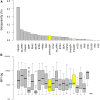Malaria Risk and Prevention in Asian Migrants to Angola
- PMID: 32815500
- PMCID: PMC7646810
- DOI: 10.4269/ajtmh.20-0706
Malaria Risk and Prevention in Asian Migrants to Angola
Abstract
The number of Asian migrants working in sub-Saharan developing countries like Angola has been increasing. Their malaria risk, prevention, and care-seeking practices have not been characterized. A cross-sectional survey was conducted in 733 Chinese and Southeast Asian migrants in Angola. Respondents were interviewed and provided blood samples. Samples were analyzed to detect Plasmodium antigen and characterize host anti-Plasmodium response. Positive samples were genotyped using the pfs47 marker. Most respondents (72%; 95% CI: 68-75) reported using bed nets, but less than 1% reported using chemoprophylaxis. Depending on the assay, 1-4% of respondents had evidence of active malaria infection. By contrast, 55% (95% CI: 52-59) were seropositive for Plasmodium antibodies. Most infections were Plasmodium falciparum, but infection and/or exposure to Plasmodium vivax and Plasmodium malariae was also detected. Seroprevalence by time in Angola showed most exposure occurred locally. One respondent had sufficiently high parasitemia for pfs47 genotyping, which showed that the infection was likely locally acquired despite recent travel to home country. Asian migrants to Angola are at substantial risk of malaria. Employers should consider enhanced malaria prevention programs, including chemoprophylaxis; embassies should encourage prevention practices. Angolan healthcare workers should be aware of high malaria exposure in Asian migrants.
Conflict of interest statement
Disclaimer: The findings and conclusion in this article are those of the authors and do not necessarily represent the official views of the CDC or the President’s Malaria Initiative. The authors declare they do not have any commercial or other associations that may pose a conflict of interest.
Figures




Similar articles
-
Molecular screening of Plasmodium infections among migrant workers in Thailand.J Vector Borne Dis. 2011 Dec;48(4):214-8. J Vector Borne Dis. 2011. PMID: 22297283
-
Malaria Surveillance - United States, 2016.MMWR Surveill Summ. 2019 May 17;68(5):1-35. doi: 10.15585/mmwr.ss6805a1. MMWR Surveill Summ. 2019. PMID: 31099769
-
The increasing importance of Plasmodium ovale and Plasmodium malariae in a malaria elimination setting: an observational study of imported cases in Jiangsu Province, China, 2011-2014.Malar J. 2016 Sep 7;15(1):459. doi: 10.1186/s12936-016-1504-2. Malar J. 2016. PMID: 27604629 Free PMC article.
-
Evaluating seroprevalence to circumsporozoite protein to estimate exposure to three species of Plasmodium in the Brazilian Amazon.Infect Dis Poverty. 2018 May 14;7(1):46. doi: 10.1186/s40249-018-0428-1. Infect Dis Poverty. 2018. PMID: 29754588 Free PMC article.
-
Case Report: Delayed or Recurrent Plasmodium falciparum Malaria in Migrants: A Report of Three Cases with a Literature Review.Am J Trop Med Hyg. 2018 Apr;98(4):1102-1106. doi: 10.4269/ajtmh.17-0407. Epub 2018 Feb 22. Am J Trop Med Hyg. 2018. PMID: 29488459 Free PMC article. Review.
Cited by
-
Access, utilization, and barriers to using malaria protection tools in migrants to Iran.BMC Public Health. 2022 Aug 25;22(1):1615. doi: 10.1186/s12889-022-13913-3. BMC Public Health. 2022. PMID: 36008787 Free PMC article.
-
Human mobility and the infectious disease transmission: A systematic review.Geo Spat Inf Sci. 2024;27(6):1824-1851. doi: 10.1080/10095020.2023.2275619. Epub 2023 Nov 29. Geo Spat Inf Sci. 2024. PMID: 40046953 Free PMC article.
-
Evaluation of various distance computation methods for construction of haplotype-based phylogenies from large MLST datasets.Mol Phylogenet Evol. 2022 Dec;177:107608. doi: 10.1016/j.ympev.2022.107608. Epub 2022 Aug 11. Mol Phylogenet Evol. 2022. PMID: 35963590 Free PMC article.
-
Antibody dynamics in children with first or repeat Plasmodium falciparum infections.Front Med (Lausanne). 2022 Jul 19;9:869028. doi: 10.3389/fmed.2022.869028. eCollection 2022. Front Med (Lausanne). 2022. PMID: 35928289 Free PMC article.
-
Occupational exposure to malaria, leishmaniasis and arbovirus vectors in endemic regions: A systematic review.Curr Res Parasitol Vector Borne Dis. 2024 Jun 1;6:100185. doi: 10.1016/j.crpvbd.2024.100185. eCollection 2024. Curr Res Parasitol Vector Borne Dis. 2024. PMID: 39027087 Free PMC article. Review.
References
-
- African Development Bank , 2019. African Economic Outlook 2020: Developing Africa’s Workforce for the Future. Abidjan, Côte d’Ivoire: African Development Bank–Building Today, A Better Africa Tomorrow; Available at: https://www.afdb.org/en/knowledge/publications/african-economic-outlook. Accessed March 20, 2020.
-
- International Labour Organization , 2019. Labour Migration in Africa. Geneva, Switzerland: International Labour Organization. Available at: http://www.ilo.org/africa/areas-of-work/labour-migration/WCMS_670561/lan.... Accessed March 20, 2020.
-
- International Organization for Migration , 2016. Glossary on Migration (2019). Grand-Saconnex, Switzerland: International Organization for Migration; Available at: https://www.iom.int/glossary-migration-2019. Accessed March 20, 2020.
-
- International Organization for Migration , 2020. World Migration Report 2020. Grand-Saconnex, Switzerland: IOM Online Bookstore; Available at: https://publications.iom.int/books/world-migration-report-2020. Accessed March 20, 2020.
Publication types
MeSH terms
LinkOut - more resources
Full Text Sources
Medical

